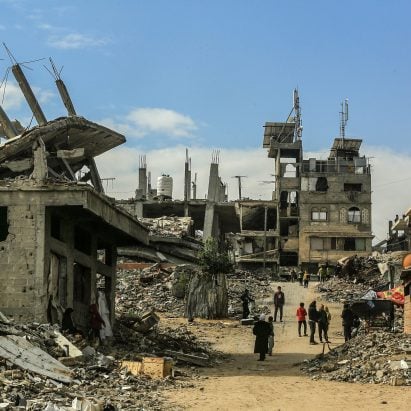A study has calculated that it could take four decades to clear the rubble from destroyed and damaged buildings caused by Israel’s bombardment of Gaza and the process would yield over 90,000 tonnes of greenhouse gas emissions.
The study, which was published earlier this month in the journal Environmental Research: Infrastructure and Sustainability, used open-source spatial data to calculate that over 36.8 million metric tonnes of concrete debris has been created from buildings destroyed and damaged by Israeli forces between 7 October 2023 and 1 December 2024.
According to the research, removing and processing this rubble could generate more than 90,000 tonnes of carbon emissions.
This would largely be due to the heavy machinery required to collect the rubble and transport it to disposal sites.
Removing rubble would take 2.1 million truck journeys
The highly complex task of clearing the destruction could also take up to 40 years, according to Samer Abdelnour, the study’s lead author and senior lecturer in strategic management at the University of Edinburgh Business School, and co-author Nicholas Roy, a statistical science master’s student at Oxford University.
The researchers estimate that it would take 2.1 million truck journeys to remove the debris to disposal sites, which would require driving 29.5 million kilometres.
According to the study, these journeys would generate almost 66,000 tonnes of carbon dioxide.
Crushing rubble would also generate carbon emissions
The other major carbon cost would be associated with crushing uncontaminated concrete rubble into aggregates for reuse in local rebuilding projects. Abdelnour and Roy compared two scenarios to highlight the carbon cost of processing uncontaminated debris.
The first scenario assumes that 80 per cent of the debris is viable for crushing. If 50 high-capacity industrial jaw crushers were used, it would take just over six months to undertake the work, resulting in around 2,976 tonnes of carbon dioxide.
However, the researchers explained that the machinery required is currently unavailable in Gaza.
The second scenario estimates that a fleet of 50 smaller crushers – that are typically used in Gaza – would take more than 37 years to process the same volume of rubble and generate about 25,149 tonnes of carbon dioxide.
The researchers also noted that the task would be complicated by the significant presence of unidentified hazards, including unexploded ordnances and toxins such as asbestos.
Study aims to highlight environmental impact of war
According to the authors, the study aims to highlight the far-reaching and often hidden climate impacts of war.
Abdelnour and Roy also wanted to provide policymakers, urban planners, civil engineers and workers on the ground with the information they would need to prepare for rebuilding Gaza.
“Of course, we recognise carbon emission estimates to be oversimplified proxies for understanding the complex, multifaceted, and enduring climate and environmental impacts of war and reconstruction,” wrote Abdelnour and Roy.
“Yet our findings do underscore the importance of considering debris removal and processing, which thus far has been an underexplored area in the calculation of military emissions,” they added.
The widespread destruction in Gaza has seen over 90 per cent of homes destroyed or damaged by Israeli forces, according to the United Nations’ Office for the Coordination of Humanitarian Affairs (OCHA).
Human rights groups around the world have condemned Israel’s most recent and ongoing military campaign in Gaza, launched in response to Hamas’s 7 October attacks in 2023, which has so far killed over 60,000 people, according to the latest figures released by Gaza’s health ministry.
Several UN reports have found Israel’s methods of warfare to be “consistent with the characteristics of genocide”. Two leading human rights groups based in Israel, B’Tselem and Physicians for Human Rights, have also said that Israel is committing genocide against Palestinians in Gaza and that the USA and European countries have a legal and moral duty to stop this from happening.
The image is courtesy of Shutterstock.
Comments have been turned off on this story due to the sensitive nature of the subject matter.
The post Gaza rubble clearance could result in 90,000 tonnes of carbon emissions appeared first on Dezeen.
